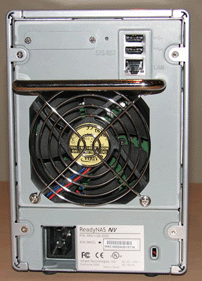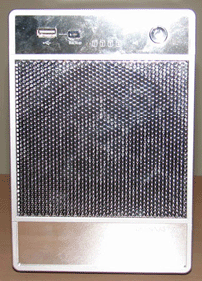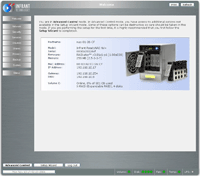SMB NAS Roundup
by Ross Whitehead Jason Clark Dave Muysson on December 5, 2006 3:30 AM EST- Posted in
- IT Computing
Infrant ReadyNAS NV+
The Infrant ReadyNAS NV+ is targeted for both home and SMB/SOHO applications. The unit is powered by an IT3107 Network Storage processor with 256MB RAM, one 10/100/1000 network port, three USB 2.0 ports, four hot-swap SATA drive bays, and 64MB Flash for the OS. There are several features included that are attractive for both home and business users. For business there is a built in DHCP and Print server, SNMP and SMTP alerts, detailed status information and logs, and Active Directory integration. For the home user there is UPnP AV, SlimServer support, Windows MCE compatibility and more. RAID 0, 1, and 5 are supported, and a new type called X-RAID is also included. Client support includes Windows, Mac, Linux, and UNIX. Protocol support includes CIFS/SMB, AFP, NFS V2 and V3, HTTP(S), and FTP(S).
Infrant also added external device support through the three USB 2.0 ports. These devices include USB Hard Disk and Flash drives, USB printers, and even USB Wireless Network Adapters. We didn't have time to test all these out, but Infrant does maintain a list of supported devices on their website.
The chassis of the NV+ is the smallest one out of all the units, and one of the nicest looking too. Dimensions are 132mm (W) x 200mm (H) x 222mm (D) and it weighs a total of 4.6Kg without hard drives. The front panel consists of a status LCD displaying the IP address and host name, one USB port, a backup button for one-touch backups, one LED for each disk drive, one LED for network activity, and an illuminated power button. The rear of the unit has two USB ports, one Gigabit port, power supply, and cooling fan. Infrant also included a solid handle that is useful for moving the unit around, but that can sometimes get in the way when disconnecting the network cable.
Infrant has included a unique feature that stands out among the rest of the units we tested. They have created a custom RAID type called X-RAID that allows you to start with one disk and grow up to four disks without loosing data or downtime. You can also increase disk capacity by swapping each drive with a larger drive one-by-one. Additional information about the benefits of X-RAID is available if you'd like to know more.
While you can't see it in the picture above, there is an LCD on the front of the ReadyNAS NV+. When powered off, the bottom looks like a solid silver plate, but powered on you can see the LCD information show through. You can see this in the Web Interface picture below.
Admin Interface
The management interface for the ReadyNAS comes in two parts: First is a custom RAIDar utility that can be used for monitoring the unit at boot up and configuring X-RAID or RAID 0/1/5 mode. Second is the web interface which allows you configure everything else on the unit. Navigation is simple with a lot of detail put into the GUI.
Pros
Cons
Retail (Shopping.com): $1,085 - $1,202
The Infrant ReadyNAS NV+ is targeted for both home and SMB/SOHO applications. The unit is powered by an IT3107 Network Storage processor with 256MB RAM, one 10/100/1000 network port, three USB 2.0 ports, four hot-swap SATA drive bays, and 64MB Flash for the OS. There are several features included that are attractive for both home and business users. For business there is a built in DHCP and Print server, SNMP and SMTP alerts, detailed status information and logs, and Active Directory integration. For the home user there is UPnP AV, SlimServer support, Windows MCE compatibility and more. RAID 0, 1, and 5 are supported, and a new type called X-RAID is also included. Client support includes Windows, Mac, Linux, and UNIX. Protocol support includes CIFS/SMB, AFP, NFS V2 and V3, HTTP(S), and FTP(S).
Infrant also added external device support through the three USB 2.0 ports. These devices include USB Hard Disk and Flash drives, USB printers, and even USB Wireless Network Adapters. We didn't have time to test all these out, but Infrant does maintain a list of supported devices on their website.
The chassis of the NV+ is the smallest one out of all the units, and one of the nicest looking too. Dimensions are 132mm (W) x 200mm (H) x 222mm (D) and it weighs a total of 4.6Kg without hard drives. The front panel consists of a status LCD displaying the IP address and host name, one USB port, a backup button for one-touch backups, one LED for each disk drive, one LED for network activity, and an illuminated power button. The rear of the unit has two USB ports, one Gigabit port, power supply, and cooling fan. Infrant also included a solid handle that is useful for moving the unit around, but that can sometimes get in the way when disconnecting the network cable.
Infrant has included a unique feature that stands out among the rest of the units we tested. They have created a custom RAID type called X-RAID that allows you to start with one disk and grow up to four disks without loosing data or downtime. You can also increase disk capacity by swapping each drive with a larger drive one-by-one. Additional information about the benefits of X-RAID is available if you'd like to know more.
 Rear |
 Front |
| Click to enlarge | |
While you can't see it in the picture above, there is an LCD on the front of the ReadyNAS NV+. When powered off, the bottom looks like a solid silver plate, but powered on you can see the LCD information show through. You can see this in the Web Interface picture below.
Admin Interface
The management interface for the ReadyNAS comes in two parts: First is a custom RAIDar utility that can be used for monitoring the unit at boot up and configuring X-RAID or RAID 0/1/5 mode. Second is the web interface which allows you configure everything else on the unit. Navigation is simple with a lot of detail put into the GUI.
 Web Interface - Status |
 Web Interface - Disks |
| Click to enlarge | |
Pros
- Professional, easy to use interface
- Small footprint
- Very quiet
- Fast
- X-RAID Expansion Simplicity
- USB Disk, Wireless Network, and Printer support
- Many useful media features like SlimServer, iTunes, UPnP
Cons
- No redundant power supply or NIC
Retail (Shopping.com): $1,085 - $1,202










23 Comments
View All Comments
yyrkoon - Friday, December 8, 2006 - link
My problem is this: I want redundancy, but I also do not want to be limited to GbE transfer rates. I've been in communication with many people, via different channels (email, IRC, forums, etc), and the best results I've seen anyone get on GbE is around 90MB/s using specific NIC cards (Intel pro series, PCI-E).The options here are rather limited. I like Linux, however, I refuse to use Ethernet channel bonding (thus forcing the use of Linux on all my machines), or possibly a combination of Ethernet channel bonding, with a very expensive 802.11 a/d switch. 10GbE is is an option, but is way out of my price range, and 4GB FC doesn't seem to be much better. From my limited understanding of their product, Intel pro cards I think come with software to be used in aggregate load balancing, but I'm not 100% sure of this, and unless I used cross over cables from one machine, to another, I would be forced into paying $300usd or possibly more for a 802.11 a/d switch again. I've looked into all these options, plus 1394b firewire teaming, and SATA port multipliers. Port multiplier technology looks promising, but is Dependant on motherboard RAID (unless you shell out for a HBA), but from what I do know about it, you couldn't just plug it in to a Areca card, and have it work at full performance (someone correct me if I'm wrong please, Id love top learn otherwise).
My goal, is to have a reliable storage solution, with minimal wait times when transferring files. At some point, having too much would be overkill, and this also needs to be realized.
peternelson - Tuesday, December 12, 2006 - link
It sounds like your needs would be solved by using a fiber channel fabric.
You need a FC nic (or two) in each of your clients, then one or more FC switches eg from Brocade or oems of their switches. Finally you need drive arrays to connect FC or regular drives onto the FC fabric.
It isn't cheap but gives fantastic redundancy. FC speeds are 1/2/4 Gigabits per second.
yyrkoon - Tuesday, December 5, 2006 - link
I've been giving Areca a lot of thought lately. What I was considering, was to use a complete system for storage, loads of disk space, with an Areca RAID controller. The only problem I personally have with my idea here is: how do I get a fast link to the desktop PC ?I've been debating back and forth with a friend of mine about using firewire. From what he says, you can use multiple firewire links, teamed, along with some "hack" ? for raising to get 1394b to 1000MBit/s, to achieve what seems like outstanding performance. Assuming what my friend says is accurate, you could easily team 4x 1394b ports, and get 500MB/s.